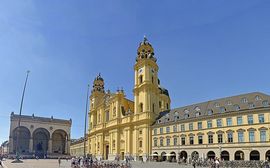THE THEATINER CHURCH – A HISTORIC JEWELL IN THE CITY

The History
The Theatiner Church was built in gratitude for the long-awaited birth of the heir to the throne Max Emanuel, when his parents Elector Ferdinand Maria and his wife Henriette Adelaide von Savoyen asked the Italian Agostino Barelli in 1662 to build the “most beautiful and precious Church”. The ground-stone was laid soon afterwards on 29 April 1663 and building was begun. Due to an argument between the architect and the constructor site manager in 1674, the facade of the Theatiner Church was left unfinished for nearly 100 years after the inauguration until after 1765, when François de Cuvilliés presented a Rococo design which his son François de Cuvilliés the Younger completed.
The Church suffered severe damage during the Second World War, and had to be rebuilt from 1946 to 1955.
The Theatiner Church is today under the care of the Dominican Order, who have had a small community within St. Kajetansince 1954.
The Interior – Totally in White
Upon entering the Church, most visitors are left surprised. Lorenzo Petri and Giovanni Viscardi worked on the interior from 1674, leaving a large part of it in a restrained and simple white. In contrast, the decoration, with its massive columns, filigree plaster work and magnificent 70 metre high cupola, is spectacular. The majestic altar is especially impressive, with its larger-than-life statues which elegantly compliment the all-round work of art, that the Theatiner Church is.
The Royal Crypt
The Theatiner Church, in line with its status as a Church of the Court, has always housed a royal crypt. The Church is, together with the St. Michael Church and the Frauenkirche, one of the most important sites for graves of the Bavarian ruling house, the Wittelsbacher. Notable is the tradition of burying the hearts of the deceased Royals in the “Altöttinger Gnadenkapelle”. The Royal Crypt currently houses the remains of 49 members of the ruling family. Among them are Emperor Charles VII, King of Greece Otto I, Elector Ferdinand Maria and his wife Henriette Adelaide von Savoyen, as well as Prince Regent Leopold von Bayern.
Platzl Hotel Munich – Insider Tip
When the Theatiner Church was built, there were already many buildings in the Theatinerstrasse through to the corner of Briennerstrasse. The context therefore led to the facade being very long. The facade of the Church now, in the absence of buildings which existed at the time of its construction, seems particularly splendid when seen from the open space of Odeonsplatz, whereas the filigree and nobel architecture are best appreciated from the perspective of the narrow streets towards Marienplatz. It would therefore be worth your while to spend some time during a walk in the city discovering and admiring the beauties of St. Kajetan.
Mass in the Theatiner Church
The doors of the Theatiner Church are open daily for visitors and for Mass between 6.30 to 20.00. During the Christmas Season, the programme is extended to included several special Advent Masses. You will find more information under here.
[Translate to Englisch:] Die Geschichte der Theatinerkirche
[Translate to Englisch:]
Die Theatinerkirche wurde zum Dank für die Geburt des lang ersehnten Thronfolgers Max Emanuel erbaut, dessen Eltern, Kurfürst Ferdinand Maria und dessen Gemahlin Henriette Adelaide von Savoyen, 1662 die „schönste und wertvollste Kirche“ bei dem Italiener Agostino Barelli in Auftrag gaben. Bereits wenige Monate später begannen mit der Grundsteinlegung am 29. April 1663 die Bauarbeiten. Aufgrund von Auseinandersetzungen zwischen dem Architekten und dem Bauleiter im Jahr 1674, blieb die Außenfassade der Theatinerkirche in München zunächst lange unvollendet. Erst rund 100 Jahre nach der Weihe entwarf François de Cuvilliés 1765 eine Fassade im Stile des Rokokos, die sein Sohn François de Cuvilliés der Jüngere vollendete.
Während des Zweiten Weltkrieges wurde die Kirche zum Teil schwer zerstört und musste daher von 1946 bis 1955 wieder aufgebaut werden. Heute wird die Theatinerkirche von den Dominikanern betreut, die seit 1954 eine kleine Niederlassung an St. Kajetan haben.
[Translate to Englisch:] Der Innenraum – Ganz in Weiß
[Translate to Englisch:]
Beim Betreten des Innenraums der Theatinerkirche sind die meisten Besucher erst einmal überrascht. Er entstand ab 1674 unter Lorenzo Petri sowie Giovanni Viscardi und ist von der Farbgebung sehr schlicht ganz in Weiß gehalten. Spektakulär ist hingegen die dekorative Ausgestaltung mit massiven Säulen, filigranem Stuck und der mächtigen Kuppel in 70 Metern Höhe. Von besonderer Wirkung ist der majestätische Hochaltar mit seinen überlebensgroßen Statuen, der sich elegant in das Gesamtkunstwerk der Theatinerkirche fügt.
[Translate to Englisch:] Die Fürstengruft in der Theatinerkirche
[Translate to Englisch:]
Aufgrund ihrer Funktion als Hofkirche besaß die Theatinerkirche bereits von Beginn an eine Fürstengruft und ist neben der Kirche St. Michael sowie der Frauenkirche eine der wichtigsten Grablegen des bayerischen Herrscherhauses der Wittelsbacher. Hervorzuheben ist dabei, dass aus einer Tradition heraus die Herzen der verstorbenen Adligen in der Altöttinger Gnadenkapelle beerdigt wurden. In der Fürstengruft sind derzeit 49 Mitglieder der Herrscherfamilie beigesetzt. Dazu zählen unter anderem auch Kaiser Karl VII., Otto I. König von Griechenland, Kurfürst Ferdinand Maria und dessen Gemahlin Henriette Adelaide von Savoyen sowie Prinzregent Luitpold von Bayern.
[Translate to Englisch:] Unser Insider Tipp
[Translate to Englisch:]
Die Theatinerkirche wurde zu einer Zeit gebaut als in der Theatinerstraße bis zur Briennerstraße noch zahlreiche Gebäude standen. Daher wurde die Fassade sehr lang gezogen. Aufgrund der damaligen Gegebenheiten wirkt die Kirche heute aus der Perspektive des Odeonsplatzes sehr prunkvoll, während aus der Perspektive der kleinen Gassen in Richtung Marienplatz die filigrane und edle Architektur zur Geltung kommt. Es lohnt sich also ein wenig mehr Zeit mit zu bringen und während eines Spaziergangs die Feinheiten von St. Kajetan zu entdecken.
[Translate to Englisch:] Messen in der Theatinerkirche
[Translate to Englisch:]
Die Türen der Theatinerkirche stehen Ihnen täglich zur Besichtigung und zum Besuch von Gottesdiensten von 6.30 Uhr bis 20.00 Uhr offen. In der Weihnachtszeit wird das Programm zudem durch einige besondere Advents-Gottesdienste ergänzt. Weitere Informationen finden sie unter www.theatinerkirche.de
Bildquelle: © 2019 – Guido F. R. Radig
